Lupine Publishers | Open Access Journal of Environmental and Soil Sciences
Abstract
Improving soil quality results in increased yields and benefits for farmers. Research has been carried out on the use of selected mineral waste collected in heaps to improve the quality of poor soils. The natural soil supplements obtained in this way will not only improve their quality and increase polonies but will also allow the liquidation of some of the heaps. This will contribute to the reclamation of the landscape and the environment.
Introduction
Soil and agricultural crops have been the object of multidirectional interests since ancient times. This is documented in scientific literature. Among other publications, a large part deals with those that concern soil as a source of nutrients for plants [1-5]. Another important field of research is publications on the role of soil fauna in improving soil quality [6-18]. Another research complex is geochemical research on the relationship of chemical fertilizers - improving the performance of soil with particular regard to the toxicity of additives, in particular those containing radioactive elements [19-24]. A lot of publications address the problem of the relation of fauna, and soil flora and its mineral composition [25-28] as well as the influence of mineral factors on the development of individual plant elements [4,5,29]. There are also publications on the use of organic waste for fertilization glkeb [30-33], the role of soil sun exposure in stabilizing its beneficial properties [34,35] and the use of the so-called. antagonistic plants [36,37].
A separate section is soil relations - geology [30,38-40], mineralogy - regulation of physical soil parameters including its water retention capacity [41]. Quite extensive literature concerns the use of natural minerals and rocks to improve the quality of soil and increase the size of crops from it [18,38-50]. It is in this trend that the presented publication is included, bearing in mind the impact of the proposed proceedings on possible environmental modifications [41,51-54].
Material and Methods of Research
The material for the research was taken from the profile of sediments found in the Devonian dolomite deposit exploited in the “Józefka” mine near Kielce (Figure 1). In addition, material from local heaps and granulates made from materials stored in heaps were collected for testing. In order to determine the mineralogical and petrographic characteristics of the obtained rocks, the following tests were carried out:
Figure 1: Wall of the excavation No. 2 of Józefek dolomite quarry. There are described rocks in the overburden.
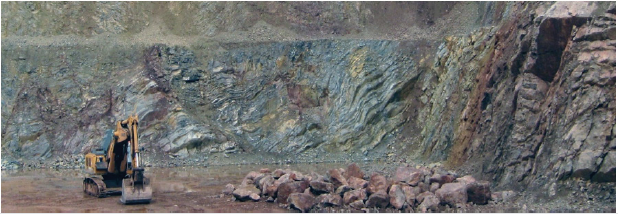
A. Microscopic examination in transmitted and reflected light. The Chinese production of Menij was used. The observed phenomena were documented with micrographs.
B. The analysis of the mineral composition of natural samples was made using the XRD method
C. In order to recognize the content of silty fractions and the clay minerals present in it, samples were sludged.
D. The analysis of the chemical composition of the obtained clay fraction was made using the XRD method
E. Analysis of the degree of quartz grain overlaying and SEM morphology of siliceous minerals as well as the non-standard qualitative analysis of the EDS spectrum (Figure 2.a & 2.b).
Figure 2a: The general appearance of sediments in the dolomite deposition. Silts and clays stained with iron and manganese oxides.
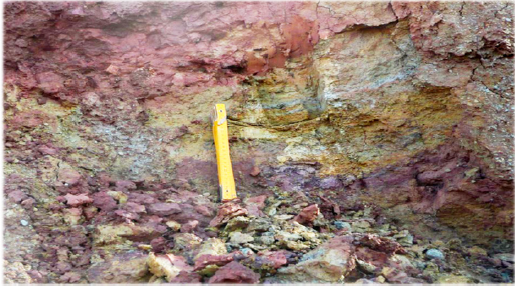
Microscopic Tests in Polarized Saint Lighting
Sand Muck
Structure: aurytowo-psamitowa, texture: compact, random Composition: quartz, min. clay, min. heavy, among which tourmaline was recognized (Figure 3). Degree of sorting of quartz grain on average sorted.
Figure 3: Microscopic photos of sandy silt. A: picture of rock at 1 polaroid, B: picture of rocks in polarized light. Visible quartz grains and brown tourmaline grain. Minerals are located in intergranular spaces.
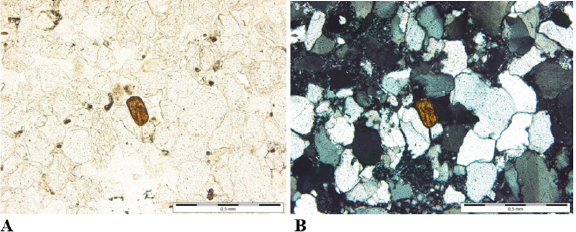
Kaolinite Heel
Structure of silty claystone, texture, texture in places parallel, disturbed. The rock background is a very low birefringent kaolinite mass (Figure 4). In the background of the rocks there are almost exclusively clay minerals, accompanied by single quartz grains with a size of up to 20μm of quartz grain, columnar aggregates of kaolinite in places with a wormlike habit.
Figure 4: Photographs of microscopic kaolinite claystone. A: picture of the rock at 1 polaroid, B: picture of the rock in polarized light. Visible different orientation of kaolinite microaggregates manifested in the variable polarization blanking mode.
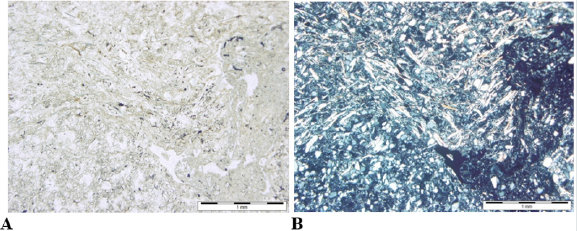
Molecular Muscovite Heel
The clay is a parallel texture made of kaolinite, smectite and muscovite (Figure 5). They are accompanied by single quartz grains.
Figure 5: Microscopic photos for kaolinite-muscovite claystone. A: picture in a non-polarized light, B: A photo in polarized light.
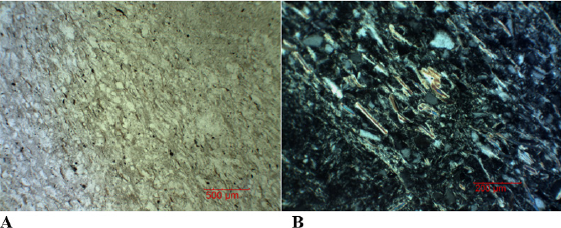
Kaolinite-Illitic Heel
Pellet structure, random texture, disturbed (flow processes) Mineral composition is a mixture of smectite and kaolinite (Figure 6). The microscopic examination shows that the overburden mainly consists of siltstones, sandy mudstones and claystone’s. The sediments are present next to quartz and clay minerals such as kaolinite and smectite also mica. Thanks to microscopic observations, several generations of quartz can be distinguished, as well as iron oxides and hydroxides responsible for the red color of the sediments.
Figure 6: Microscopic images of kaolinite-illite claystone. A: Image in natural light, B: Image in polarized light. in which the granulometric composition was determined. B: granulometric curve of the tested samples.
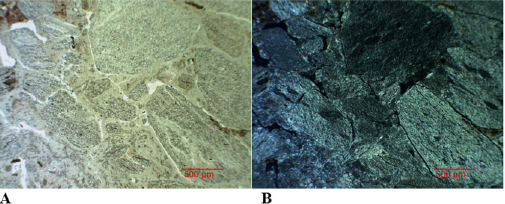
Analysis of the External Matrix of Natural Tests Used by the XRD Method
Due to the uncertainty of the clay components, the polarizing microscopy method was used to test the X-ray diffraction method. Analyzes of natural samples, clayey, prażed and glycolated fractions were performed (Graphs 1,1a,2, 2a,3, 3a,4,4a,5). They allowed to state that beside the detritus components in the overburden samples and heaps there are clay minerals represented by kaolinite and illite. X-ray examinations indicate that all overburden sediments and heaps occurring in the heap contain minerals beneficial for agriculture. They do not contain toxic minerals (Figure 5.a).
Graph 1a: X-ray diffraction pattern for silt sand grain fractions. From the top: raw, roasted and glycolated preparation.
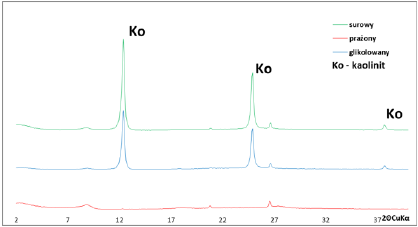
Graph 2.a: X-ray diffractogram of clay fraction of kaolinite claystone. From the top: raw, roasted and glycolated preparation.
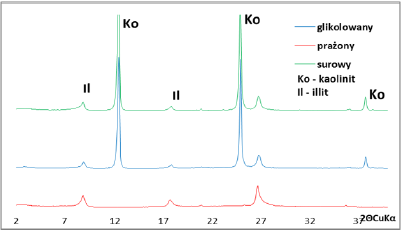
Graph 3.a: X-ray diffractogram for clay fraction of clay-muscovite clay. From the top: raw, roasted and glycolated preparation.
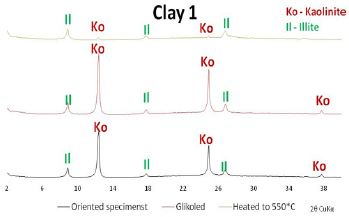
Graph 4.a: X-ray diffractogram for clay fraction of clay-illite clay. From the top: raw, glycolated and roasted preparation.

Results Designated by Content of The Content of the Cross-Fraction on a Standing Water Post
In the case of two samples, the content of clay minerals (fraction <2 μm) in selected samples with extremely small and extremely high clay minerals were tested. They showed that the amount varies both in the overburden material and material from the heap from 3 to 64% by weight (Table 1).
Results of the Analysis of the Quarter of Quartz Grassing and Distribution of Minerals of Chlorine Minerals in Granulates SEM
SEM observations were made for both overburden and granulate deposits. Their distribution in pellets is of great importance as they favor the disintegration of granules and thus the dispersion of granulated material in the enriched soil. Clay minerals in overburden scales are present as aggregates of kaolinite or illite microcells (Figure 7). On the other hand, both on the heap and in the granulate, clay aggregates are degraded by micrometry (Figure 8), which means that in the process of stripping off, staying on heaps and in the granulation process, the clay aggregates disintegrate. This is a favorable phenomenon conducive to material granulation. After pouring on granules, thanks to such a construction, they undergo a faster process of foresting. thanks to which the ingredients of the granules combine with the glaze more quickly.
Figure 7: Kaolinite doline from the dolomite overburden. A: characteristic aggregates made of kaolinite tiles. B: one of the aggregates under magnification.
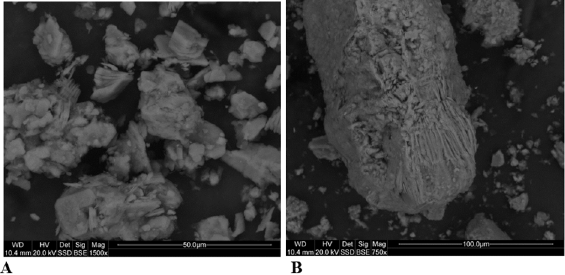
Figure 8: Granules, visible quartz grains (blue arrows) and dolomite (orange arrow) stuck together with clay minerals. SEM image.
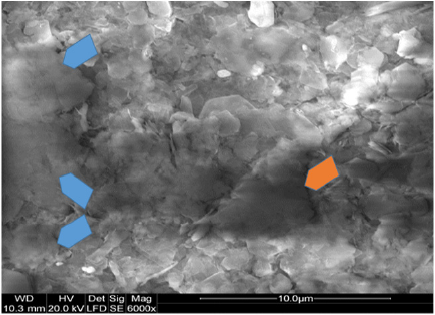
SEM Images (Figures 9-11)
Figure 9: The heap of Józefek quarry. containing overburden rocks collected from the Devonian dolomites.
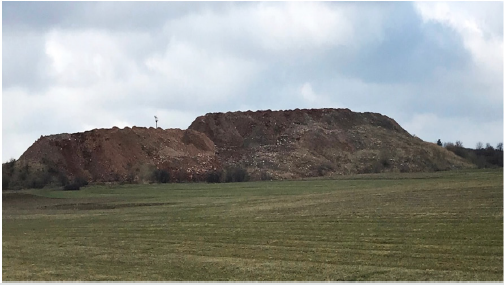
Figure 10: Granules with different granulation of soil supplements with different grain size, which were made from sediments accumulated in heaps.
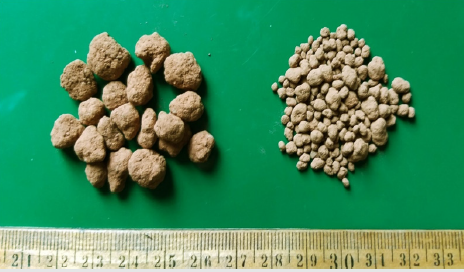
Figure 11: Granular structure observed in the cross-section of granules. Visible dolomite grains in the clay anchor. A: magnification 10 x, B: magnification 20 x.
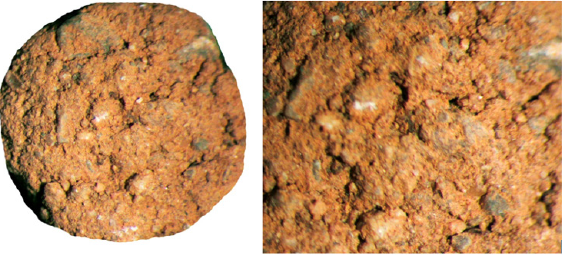
Summary
The performed research indicates that in the dolomite deposit of the Józefka deposit, rocks containing clay minerals from the kaolinite and illite groups as well as quartz, dolomite and calcite are present. The origin of these rocks is not fixed, but for raw material reasons, these rocks are suitable for enriching class IV-VI soils with clay minerals that can provide many ions and promote water retention in soil. Natural granules made from overburden rocks deposited on heaps and small dolomite fractions (waste) can be used as soil supplements enriching it with many elements, including magnesium. It is a beneficial stimulator of biological processes in plants. The use of the described granulates as soil supplements will increase yields, biologically strengthen growing plants and contribute to increasing harvests, and thus will increase the profits of agricultural producers. Both magnesium and other elements that will be delivered to the soil with granules will naturally become the building blocks of plant tissues. In the production and processing cycle, they will then be transferred to organisms using the bred plants. These soil supplements are completely natural and do not contain synthetic toxic substances. They are therefore environmentally friendly and human. The use of granules in the described form will not only strengthen the soil, but will also help to eliminate mineral heaps, favoring the reclamation of mining areas and restoring them to natural conditions.
https://lupinepublishers.com/environmental-soil-science-journal/pdf/OAJESS.MS.ID.000145.pdf
For more Lupine Publishers Open Access Journals Please visit our website: https://lupinepublishersgroup.com/
For more Open Access Journal on Environmental and Soil Sciences
articles Please Click Here:
https://lupinepublishers.com/environmental-soil-science-journal/
To Know More About Open Access Publishers Please Click on Lupine Publishers
Follow on Linkedin : https://www.linkedin.com/company/lupinepublishers
Follow on Twitter : https://twitter.com/lupine_online

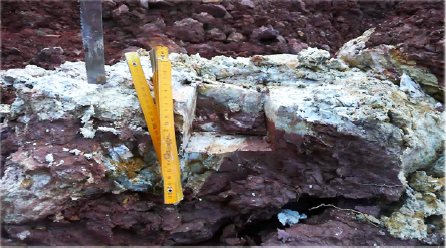
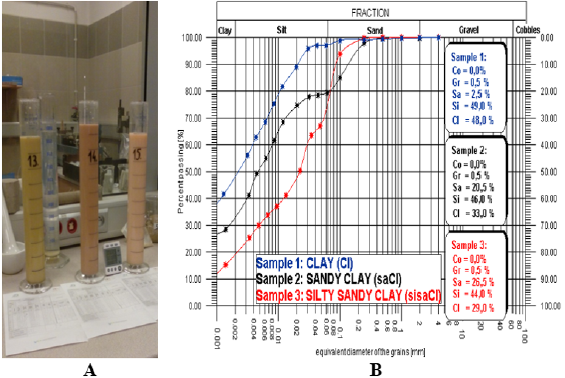
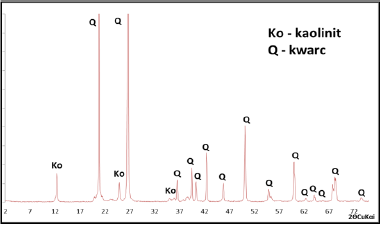
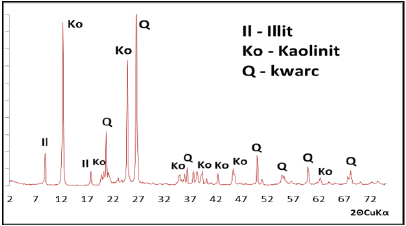
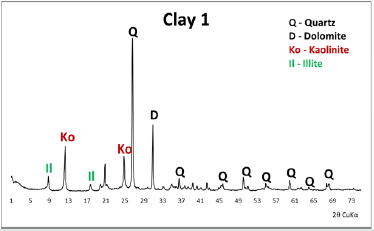
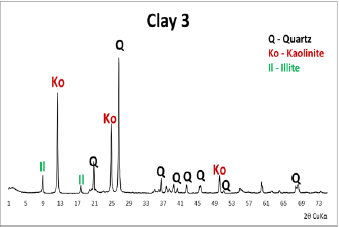
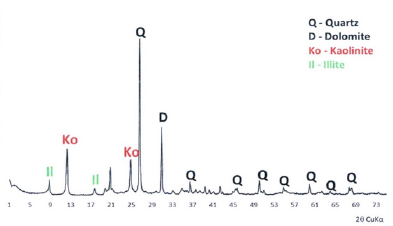

No comments:
Post a Comment